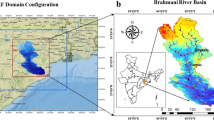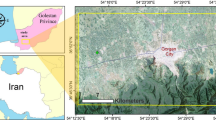Abstract
The downward shortwave radiation (DSR) is an essential parameter of land surface radiation budget and many land surface models that characterize hydrological, ecological and biogeochemical processes. The new Global LAnd Surface Satellite (GLASS) DSR datasets have been generated recently using multiple satellite data in China. This study investigates the performances of direct comparison approach, which is mostly used for validation of surface insolation retrieved from satellite data over the plain area, and indirect comparison approach, which needs a fine resolution map of DSR as reference, for validation of GLASS DSR product in time-steps of 1 and 3 hours over three Chinese Ecosystem Research Network sites located in the rugged surface. Results suggest that it probably has a large uncertainty to assess GLASS DSR product using the direct comparison method between GLASS surface insolation and field measurements over complex terrain, especially at Mt. Gongga 3,000 m station with root mean square error of 279.04 and 229.06 W/m2 in time-steps of 1 and 3 hours, respectively. Further improvement for validation of GLASS DSR product in the rugged surface is suggested by generation of a fine resolution map of surface insolation and comparison of the aggregated fine resolution map with GLASS product in the rugged surface. The validation experience demonstrates that the GLASS DSR algorithm is satisfactory with determination coefficient of 0.83 and root mean square error of 81.91W/m2 over three Chinese Ecosystem Research Network sites, although GLASS product overestimates DSR compared to the aggregated fine resolution map of surface insolation.
Similar content being viewed by others
References
Annear RL, Wells SA (2007) A comparison of five models for estimating clear-sky solar radiation. Water Resource Research 43(W10415): 1–15. DOI:10.1029/2006WR005055
Bird RE, Hulstrom RL (1981) A simplified clear sky model for direct and diffuse insolation on horizontal surfaces. SERI Report TR-642-761. Golden, USA.
Chen FB, Gao SH (1993) Studies on the alpine ecology and environment of Gongga Mountain. Chengdu University of Science and Technology Press. (In Chinese)
Cheng GW, Wang GX (2010). The Site-specific observation and Research datasets of Chinese Ecosystem — Volume of Forest Ecosystem (Mt. Gongga Station in Sichuan Province). China Agriculture Press, Beijing. (In Chinese)
Gao BC, Kaufman YJ (2003) Water vapor retrievals using Moderate Resolution Imaging Spectroradiometer (MODIS) near-infrared channels. Journal of Geophysical Research, 108(D13): 4389. DOI:10.1029/2002JD003023
Gui S, Liang S, Wang K, et al. (2010) Assessment of three satellite-estimated land surface downwelling shortwave irradiance data sets. IEEE Geoscience and Remote Sensing Letters 7(4): 776–780. DOI:10.1109/LGRS.2010.2048196
He L, Qin Q, Liu M, et al. (2012) Validation of GLASS albedo products using ground measurements and Landsat TM data. IEEE International Geoscience and Remote Sensing Symposium, Munich, Germany, 22-27 July 2012. DOI: 10.1109/IGARSS.2012.6351353
Houborg R, Soegaard H, Boegh E (2007) Combining vegetation index and model inversion methods for the extraction of key vegetation biophysical parameters using Terra and Aqua MODIS reflectance data. Remote Sensing of Environment 106(1): 39–58. DOI:10.1016/j.rse.2006.07.016
Journee M, Bertrand C (2010) Improving the spatio-temporal distribution of surface solar radiation data by merging ground and satellite measurements. Remote Sensing of Environment 114(11): 2692–2704. DOI:10.1016/j.rse.2010.06.010
Kaufman YJ, Wald AE, Remer LA, et al. (1997) The MODIS 2.1-μm channel-correlation with visible reflectance for use in remote sensing of aerosol. IEEE Transactions on Geoscience and Remote Sensing 35: 1286–1296. DOI: 10.1109/36.628795
Kim HY, Liang S (2010) Development of a hybrid method for estimating land surface shortwave net radiation from MODIS data. Remote Sensing of Environment 114(11): 2393–2402. DOI:10.1016/j.rse.2010.05.012
Laszlo IP, Ciren H, Liu S, et al. (2008) Remote sensing of aerosol and radiation from geostationary satellites. Advances in Space Research 41(11): 1882–1893. DOI:10.1016/j.asr.2007. 06.047
Liang S (2000) Narrowband to broadband conversions of land surface albedo I Algorithms. Remote Sensing of Environment 76: 213–238. DOI: 10.1016/S0034-4257(00)00205-4
Liang S, Wang K, Zhang X, et al. (2010) Review on estimation of land surface radiation and energy budgets from ground measurement, remote sensing and model simulations. IEEE Journal of Selected Topics in Applied Earth Observations and Remote Sesning 3(3): 225–240. DOI: 10.1109/JSTARS.2010.2048556
Liao Y, Gai Y, Fan W, et al. (2012) Validation methods of LAI products based on scaling effect. IEEE International Geoscience and Remote Sensing Symposium, Munich, Germany, 22–27 July 2012. DOI: 10.1109/IGARSS.2012.6351200
Liu ZG (1985) Vegetation of Gongga Mountain. Sichuan Science and Technology Press. (In Chinese)
Lu N, Liu R, Liu J, et al. (2010) An algorithm for estimating downward shortwave radiation from GMS5 visible imagery and its evaluation over China. Journal of Geophysical Research 115(D18102): 1–15. DOI:10.1029/2009JD013457
Masek JG, Vermote EF, Saleous NE, et al. (2006) A Landsat surface reflectance dataset for North America, 1990-2000. IEEE Geoscience and Remote Sensing Letters 3(1): 68–72. DOI:10.1109/LGRS.2005.857030
Qin H, Kawai Y, Kawamura H (2006) Comparison of downward surface solar radiation derived from GMS5/VISSR and of reanalysis products. Journal of Oceanography 62: 577–586. DOI: 10.1002/jgrd.50353
Qin J, Chen Z, Yang K, et al. (2011) Estimation of monthly mean daily global solar radiation based on MODIS and TRMM products. Applied Energy 88: 2480–2489. DOI:10.1016/j.apenergy.2011.01.018
Raschke E, Bakan S, Kinne S (2006) An assessment of radiation budget data provided by the ISCCP and GEWEX-SRB. Geophysical Research Letters 33(L07812): 1–5. DOI:10.1029/2005GL025503
Ryu Y, Kang S, Moon SK, et al. (2008) Evaluation of land surface radiation balance derived from moderate resolution imaging spectroradiometer (MODIS) over complex terrain and heterogeneous landscape on clear sky days. Agricultural and Forest Meteorology 148(10): 1538–1552. DOI:10.1016/j.agrformet.2008.05.008
Savtchenko A, Ouzounov D, Ahmad S, et al. (2004) Terra and Aqua MODIS products available from NASA GES DAAC. Advances in Space Research 34(4): 710–714. DOI:10.1016/j.asr.2004.03.012
Scientific Committee of Chinese Ecosystem Research Network (2007) Protocols for standard atmosphere environmental observation and measurement in terrestrial ecosystems. China Environmental Science Press, Beijing. (In Chinese)
Shen ZH, Fang JY, Liu ZL, et al. (2001) Patterns of biodiversity along the vertical vegetation spectrum of the east aspect of Gongga mountain. Acta Phytoecologica Sinica 25(6): 721–732. (In Chinese)
Stuhlman RM, Rieland M, Raschke E (1990) An improvement of the IGMK model to derive total and diffuse solar radiation at the surface from satellite data. Journal of Applied Meteorology 29: 586–603. DOI: 10.1175/1520-0450(1990)029〈0586:AIOTIM〉2.0.CO;2
Tang B, Li ZL, Zhang R (2006) A direct method for estimating net surface shortwave radiation from MODIS data. Remote Sensing of Environment 103(1): 115–126. DOI: 10.1016/j.rse.2006.04.008
Trnka M, Zalud Z, Eitzinger J, et al. (2005) Global solar radiation in Central European lowlands estimated by various empirical formulae. Agricultural and Forest Meteorology 131: 54–76. DOI:10.1016/j.agrformet.2005.05.002
Vermote EF, Elsaleous N, Justice C (2002). Atmospheric correction of the MODIS data in the visible to middle infrared: first results. Remote Sensing of Environment 83: 97–111. DOI: 10.1016/S0034-4257(02)00089-5
Wali MK, Evrendilek F, West T, et al. (1999) Assessing terrestrial ecosystem sustainability: usefulness of regional carbon and nitrogen models. Natural and Resource 35(4): 20–33.
Wang K, Zhou X, Liu J (2004) The effects of complex terrain on the computed surface solar shortwave radiation. Chinese Journal of Atmospheric Sciences 28(4): 625–633. (In Chinese)
Wielicki BA, Barkstrom BR, Harrison E F, et al. (1996) Clouds and the Earth’s Radiant Energy System (CERES): an Earth observing system experiment. Bulletin of the American Meteorological Society 77(5): 853–868. DOI: 10.1175/1520-0477(1996)077<0853:CATERE>2.0.CO;2
Yang K, He J, Tang W, et al. (2010) On downward shortwave and longwave radiations over high altitude regions: Observation and modeling in the Tibetan Plateau. Agricultural and Forest Meteorology 150(1): 38–46. DOI: 10.1016/j.agrformet.2009.08.004
Zhang XT (2010) Estimation of land surface incident solar radiation and photosynthetically active radiation. PhD Dissertation of Wuhan University, Wuhan. (In Chinese)
Zhang Y, Rossow WB, Stackhouse PW. (2006) Comparison of different global information sources used in surface radiative flux calculation: Radiative properties of the surface. Journal of Geophysical Research 112(D01102): 1–20. DOI:10.1029/2005JD007008
Zhong XH, Zhang WJ, Luo J (1999) The characteristics of the mountain ecosystem and environment in the Gongga Mountain region. Ambio 28: 648–654. (In Chinese)
Zhu B, Gao M (2010) The Site-specific observation and Research datasets of Chinese Ecosystem — Volume of Agricultural Ecosystem (Yanting Station in Sichuan Province). China Agriculture Press, Beijing. (In Chinese)
Author information
Authors and Affiliations
Corresponding author
Rights and permissions
About this article
Cite this article
Jin, Ha., Li, An., Bian, Jh. et al. Validation of global land surface satellite (GLASS) downward shortwave radiation product in the rugged surface. J. Mt. Sci. 10, 812–823 (2013). https://doi.org/10.1007/s11629-013-2543-6
Received:
Accepted:
Published:
Issue Date:
DOI: https://doi.org/10.1007/s11629-013-2543-6




